Chinese Works of Art Hand Painted Box Ming Dynasty
Identifying Marks and Inscriptions
MARKS AND INSCRIPTIONS ON CHINESE PORCELAIN AND POTTERY
Introduction
Identifying Chinese and Japanese Ceramics is more than merely looking at the marks and inscriptions. It is very important to see it into the context of multiple things.
- How the porcelain feels to the touch.
- What the weight feels similar in your hands.
- How the painting is excecuted also equally the field of study of the painting.
- The colour of the glaze, its sheen and thickness.
- The shape and proportions of the piece.
Allot of this is a mather of picking up many pieces and feel many different textures. Only through treatment ceramics and looking at them 1 can truly learn the differences. This is process that takes many years to learn. It is not an exact science.
Many oriental ceramic objects have marks, a marking might declare that the piece was made at a certain period. However, identifying the marker tin give a misleading impression of the period the object was made in. For case, there are many pieces of bluish and white porcelain with the marker of the Ming emperor Chenghua. He reigned from 1465-1487. So yous would exist forgiven for thinking yous a had piece of Ming porcelain. Many pieces made during the Kangxi period (1662-1722) blank the marking of Chenghua. This was not a question of charade but of reverence to a gold age of porcelain production in People's republic of china.
On this folio I would similar to share some of my knowledge into the identification of the marks and inscriptions. It took me many years to learn the different variations and I still acquire every day.
Hopefully, by showing the marks as they appear on the objects, it will help give context. Making it easier to understand what type of mark you might expect to find on blazon of pottery or porcelain.
- Vocal Dynasty 960-1279
- Jin 1115-1234 and Yuan Dynasty 1279 – 1368
- Ming Dynasty 1368 -1644
Vocal Dynasty 960-1279
Nothern Song Dynasty 960-1127
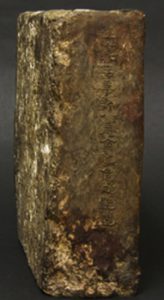
A Rare Inscribed Northern Song Tile, Probably from the 'Iron Pagoda' of Youguosi, Kaifeng Henan Province. The Pottery Wall Tile Glazed in Amber and Green, Decorated with Buddha Surrounded past Bodhisattvas and Disciples. The Side Inscribed in Raised Moulded Script. For a Very Similar but Double Tile Lacking the Inscription Come across : The British Museum Detail OA 1992.two-6.one. The British Museum Entry Further States "Some Pagodas in the Vocal Dynasty Were Fabricated Entirely of Bandage Iron. Pagodas Fully Covered with Brown-Glazed Pottery Tiles had a Like Visual Effect and are Oftentimes Called Atomic number 26 Pagodas" east our 'Annal' for more information, stock number 17462
Southern Vocal Dynasty 1128-1279
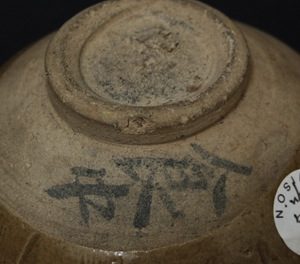
A Contemporary Ink Inscription While Eating.
An Inscribed Song Stoneware Bowl with Incised and Combed Petal Ornamentation. The Inscription Which is Contemporary With the Basin Reads 'While Eating'. This Unusual Inscription Probably Marks this Piece out equally a Vessel Used in a Vocal Dynasty Restaurant.
Provenance :
Gerald Davison.Label to the side C.P. 133.
Literature :
The Handbook of Marks on Chinese Ceramics (Gerald Davison, Han-Shan Tang Books, 1994. ISBN 0-906610-20-6) Illustrated on Page 23 Item 21.
Jin 1115-1234 and Yuan Dynasty 1279 – 1368
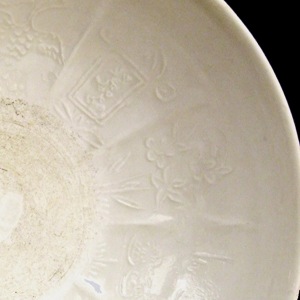
A Rare Jiexiu Ware Inscribed Porcelain Basin from the Jiexiu Kilns in Shanxi Province. The Basin has Panels Divided by Ribs. The Ornamentation is Synthetic of Raised Lines and Includes Two Inscribed Tablets with Lotus Foliage Tops. The Rare Inscription reads "Porcelain Vessel". Other Panels Evidence pairs of Duck, Phoenix and Flowers.
Published :
Chinese Ceramics in the Carl Kempe Collection (Bo Gyllensvard, Almqvist & Wiksell, 1964) Page 137 Plate 433. Cartoon of the inscription Folio 147.
See our 'Archive' or 'Sold' for more than information, stock number 20375
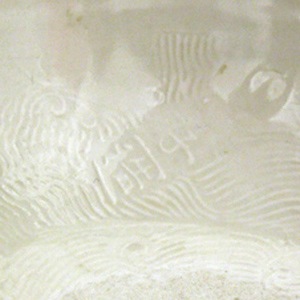
A Fine Inscribed Jiexiu White Stoneware Bowl from the Jiexiu Kilns in Shanxi Province, Jin or Yuan Dynasty, 12th or 13th Century. As part of the decoration an inscription reading "zhen fu jia kang" meaning 'veritable happiness and well-being for your family' is included at an angle.
See our 'Annal' or 'Sold' for more information, stock number 19509
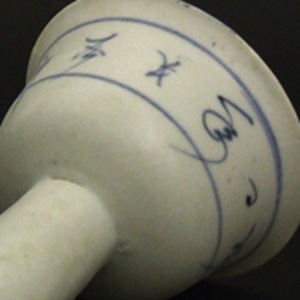
A Rare Yuan Bluish and White Porcelain Stem Cup. Decorated with a Panel of Calligraphy. The Inscription would Seem to Bequeath Good Wishes to the User. Exhibited at ; The Oriental Ceramic Society of Hong Kong's Exhibition of Trade Ceramics, Detail 89. Characterization to the Base and another to the Fitted Box. For a very Like Inscribed Blue and White Yuan Stem Cup See : Chinese Blueish and White Ceramics (S.T. Yeo & Jean Martin,Arts Orientalis,1978) Page 96, Illustrated Plate 2, Item 3.
See our 'Archive' or 'Sold' for more than information, stock number 17615.
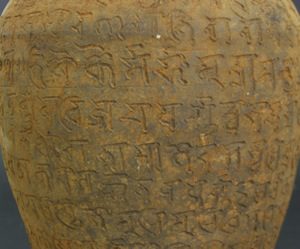
An Unidentified None-Chinese Inscription from Yunnan Province.
An Unusual Yuan Pottery Jar and Cover from Yunnan Province. The Torso Extensively Inscribed with a Non-Chinese Script. The Inscribed Characters were Added When the Clay was Wet, Some of Which Extended to the Base. A Big Expanse of the Torso Has Fired to a Black Tone. The Embrace is Undecorated. For Similar Yuan Pottery Examples See : Offering Vessels of Yunnan (Michael C. Teller IV, TK Asian Antiquities,2004) Pages 36 -37, Items 21-23. The Introduction of the Catalogue States that "A big number of jars take some calligraphy, both Chinese and every bit nevertheless (an)unidentified script, which bears pregnant similarities to post 10th century Devanagari, a script used to write sacred Sanskrit texts. Approximately 1% of the jars, still, have script all over the vessel…".
Come across our 'Archive' for more data, stock number 19093.
Ming Dynasty 1522-1644
JIAJING 1522-1666
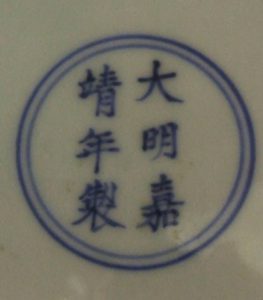
A Ming Regal Xanthous Porcelain Dish.
From the offset of Jiajing's reign, he was infatuated with young women and Taoist pursuits. He was known to be a cruel and self-aggrandizing emperor and he also chose to reside outside of the Forbidden metropolis in Beijing so he could live in isolation while ignoring state affairs. Jiajing employed incapable individuals such equally Zhang Cong and Yan Gao, on whom he thoroughly relied to handle diplomacy of state. He abandoned the practice of seeing his ministers altogether from 1539 onwards and for a period of almost 25 years refused to give official audiences, choosing instead to relay his wishes through eunuchs and officials. This somewhen led to corruption at all levels of the Ming authorities. Jiajing's ruthlessness besides led to an internal plot past his concubines to assassinate him in 1542 past strangling him while he slept. The plot was ultimately foiled and all of the concubines involved were summarily executed.
See our 'Archive' for more than information, stock number 16895
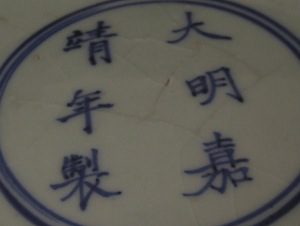
Jiajing 6 Graphic symbol Mark and of the Catamenia.
Jiajing 1522 – 1566, Large Ming Porcelain Basin. The Bowl is Busy with a Extensive Mural With Three Scholars and their Attendants with Pavilions and Mountains. The Well of the Bowl is Decorated with 'The Three Friends of Winter' (Pine, Bamboo, and Prunus). The Base of operations with a Jiajing Six Graphic symbol marking and of the Catamenia.
See our 'Archive' for more information, stock number 16905
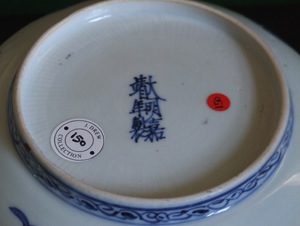
Jiajing Six Character Marking and of the Period.
A Ming Blue and White Porcelain Shallow Basin. Decorated with Fish on the Cavetto, a Crane Between 2 Egrets to the Well and Repeated 'Shou' Characters to the Everted Rim.
Provenance : Robert McPherson Antiques. The John Drew Collection.
Run into our 'Archive' for more information, stock number 18550
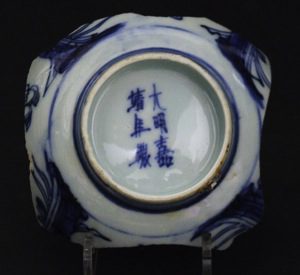
Jiajing Six Grapheme Marking and of the Period.
A Ming Blue and White Porcelain kiln Waster. This Base of a Bowl is Painted with a Male figure with a Deer.
See our 'Annal' for more information, stock number 29.
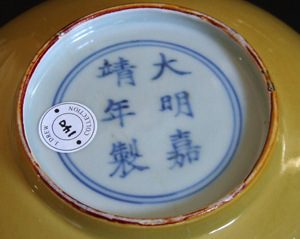
An Ming Royal Yellowish Porcelain Bowl.
For a Jiajing Majestic Yellow Bowl of the Same Size See : Christie'southward New York, Fine Chinese Furniture, Ceramics and Works of Art, 20th September 2001. Lot 379.
For a Like but Smaller Jiajing Imperial Xanthous Bowl From the Cunliffe Collection Meet : Phillip's, Bond Street, London, 13th June 2001. Lot 240.
Provenance : Robert McPherson Antiques. The John Drew Collection.
See our 'Annal' for more information, stock number 18546
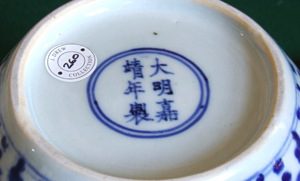
Jiajing Six Character Mark and of the Menstruum.
A Ming Blue and White Porcelain Jar.
Provenance : Robert McPherson Antiques. The John Drew Collection.
Counterfeit JIAJING MARKS AND LATER MARKS COPYING JIAJING
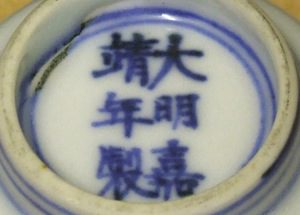
Apocryphal marks are frequently encountered on Chinese porcelain particularly on Kangxi Blue and White Porcelain, the marking of the Ming Emperor Chenghua who reigned from 1465 to 1487 beingness by far the most common, other Ming marks include Jiajing (1522-1566) and less frequently Wanli (1573-1620). These marks were not unremarkably added to the piece to deceive, just more every bit a sign of reverence to before potters of the Ming dynasty (1368-1644). Occasionally they are used on pieces copying Ming Porcelain, these objects were probably fabricated for collectors who could not afford the Ming original. Tianqi (1621-1627) appears to be the primeval period for such an apocryphal mark.
Some Chongzhen and Shunzhi apocryphal marks copying Jiajing marks are very well draw, the calligraphy can be bold and confident, then occasionally these pieces are confused with genuine Jiajing mark and menstruum porcelain.
The Base with a Apocryphal Jiajing Mark (1522-1566).
A Fine Transitional Porcelain Cup, Belatedly Ming Dynasty (Chongzhen 1628-1644) or Very Early Qing Dynasty (Shunzhi 1644-1661) c.1640-1650. Decorated in a Rich Cobalt Blue with 2 Dragons with Lotus Coming from their Mouths and Buddhist Emblems.
See our 'Annal' for more than information, stock number 19042.
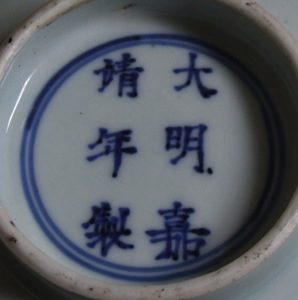
The Base of operations with an Apocryphal Jiajing Six Character Mark.
A Shunzhi Porcelain Dish. Belatedly Transitional Porcelain c.1650-1660. Thickly Potted of Shallow Class. Decorated in Blue and White with the 'Eight Horses' of Mu Wang within a Landscape. The Base with a Jiajing Vi Grapheme Mark.
See our 'Annal' for more than data, stock number 18594.
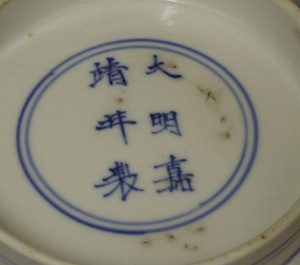
An Counterfeit Jiajing Marker, Kangxi Menses 1662-1722.
A Fine Kangxi Porcelain Bowl. Decorated with Egrets Standing in H2o Among Flowering Lotus Plants. The Base with a Jiajing Mark (Ming 1522-1566).
Come across our 'Archive' for more information, stock number 18705
LONGQING 1567 – 1572
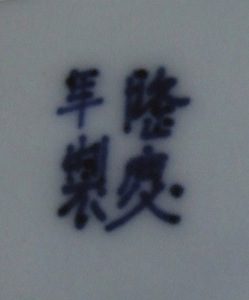
Four Character Longqing Mark and of the Period 1567 – 1572.
Longqing mark and period porcelain is rare, the marks are not particularly well painted and they are normally rather small. They are nearly always a four character mark, they practise not seem to have been copied except by modern fakers.
Longqing (March 4, 1537- July 5, 1572) was the 12th Emperor of Mainland china (Ming dynasty) and Reigned between 1567-1572. Built-in Zhu Zaihou, he was the Jiajing Emperor's son. Realizing the depth of chaos his father'southward long reign had caused, Longqing prepare about reforming the government and employing talented officials in the hope of mending the situation. He reinstigated merchandise with other empires in Europe, Africa and other parts of Asia and also reinforced border security, nominating several generals to patrol the borders by state and on sea. This included the fortification of seaports along the Zhejiang and Fujian declension to deter pirates, a constant nuisance during the Jiaqing emperor's reign. Emperor Longqing died in 1572 subsequently a short reign of only half-dozen years and was succeeded by his son. He is generally considered one of the more than liberal and open-minded emperors of the Ming dynasty. Unfortunately, the country was nevertheless in pass up due to corruption in the ruling class. The emperor Longqing was buried in Zhaoling.
A Rare Ming Porcelain Dish, 4 Character Longqing Marker and of the Period. Decorated with Three 'Chilong' Dragons in Blue and White, the Center with 'Anhua' Decorated 'Lingzhi' Fungus.
Provenance :
Philip'southward Bond Street, Chinese and Japanese Porcelain, 19th Nov 1999, Lot half-dozen.
Robert McPherson Antiques.
The John Drew Collection.
A Longqing Dish of this Design was Exhibited in Deutschland See : Ming-Porzellane in Schwedischen Sammlungen (Berlin and Leipzig 1935) Collection of H.Lauritzen, Stockholm.
See our 'Annal' for more data, stock number 18597
Everyone was now in such a muddle that there was a sort of gentleman'southward agreement not to talk about it whatever more
- Gerald Reitlinger (1900- 1978)
WANLI 1573 – 1620

Wanli Six Grapheme Mark with the Inclusion of 'Beautiful Vessel for Jade Hall' Wanli nian zhi Yu Tang Jia Qi.
A Rare Wanli Blueish and White Porcelain Bowl. The Base of operations with a Wanli Mark Incorporating Yu Tang Jia Qi (Cute Vessel for Jade Hall). This Thinly Potted Wanli Porcelain Bowl is of Round Form with a Slightly Everted Rim and Curved Sides, it is Covered past a Pale Blue-Gray Tinged Glaze, the Interior Painted in Fine Bright Underglaze Cobalt Blue with a Double Circumvolve Enclosing a Medallion of Flowering Branches of Peony, the Underside Encircled Alternately by Roundels Enclosing Flowering Sprays and Fruiting Sprays Amongst Cloud Scrolls.
This rare mark, a standard Wanli six character marker with the inclusion of 'Beautiful Vessel for Jade Hall' Wanli nian zhi Yu Tang Jia Qi is very neatly painted different marks on none-imperial Wanli porcelain. The present example is almost certainly imperial, the addition of the hall mark within the Wanli reign mark might not announce that this bowl was made for a specific imperial hall.
Ming Wilson explains in 'Rare Marks on Chinese Ceramics' when discussing a Wanli bowl with a eight character mark that includes the characters pregnant 'for use in the Hall of Pure loyalty' that the basin was made for an official at court. The name 'Hall of Pure loyalty' was bestowed by Wanli on the high ranking official Zhang Juzheng (1525-1582). So it is quite possible the present example was besides made for a high ranking official at the purple courtroom, nevertheless information technology is likewise possible the hall mark does indeed announce the place which the bowl was destined for.
Gerald Reitlinger (1900- 1978)
Regarding porcelain reign marks and dating (1881):
'Everyone was at present in such a muddle that there was a sort of gentleman'due south understanding not to talk about it any more.'
From our 'History' department, see ;
CHINESE PORCELAIN
25 YEARS OF UNSCHOLARY COLLECTING:
An Entertainment and an Anthology of Scholars' Taste.
past D.R Laurence MD, 2003
For a pair Wanli dishes with the mark discussed above see : Rare Marks on Chinese Ceramics, A Articulation Exhibition from the Percival David Foundation of Chinese Art and the Victoria and Albert Museum (Ming Wilson, School of Oriental and African Studies in association with Victoria and Albert Museum. 1998. ISBN 0-7286-0290-3) pages 48 and 49 also as the introduction.
See our 'Archive' for more than information, stock number 20396
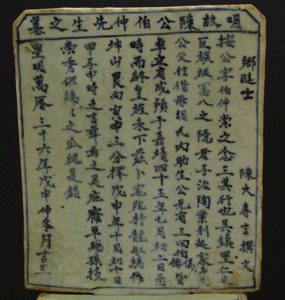
This extensively inscribed Ming blue and white stele is dated to the thirty-sixth year of Wanli (1609) and the day equivalent to November 2nd. The inscriptions on the front end and back show that Cheng Bozhong had passed the Royal Examinations, he had a family unit, their names are too noted.
A Rare Dated Ming Blue and White Porcelain Stele. Dated to November 2d 1609. Synthetic of a Rectangular Porcelain Slab with a Flange that Inserts into a Brick Form Base of operations. Ming blue and white porcelain stele are very rarely found outside museum collections.
Provenance :
The Museum of Art and Far Eastern Antiquities in Ulricehamn Sweden.
Published :
Chinese Ceramic Treasures, A Choice From Ulricehamn Due east Asian Museum, Including The Carl Kempe Collection (National Museum of Art and Far Eastern Antiquities in Ulrichenhamn, Sweden, 2002.ISBN 91-971367-4-3)Pages 250 and 251. Both sides illustrated in colour with a full translation into Swedish.
Run into our 'Annal' for more information, stock number 20396
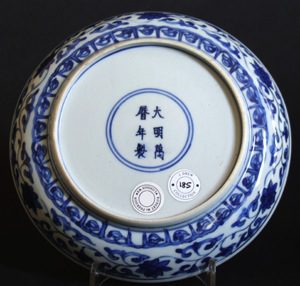
Wanli Six Character Marking and of the Period.
A Ming Porcelain Dish. Wanli Six Graphic symbol Mark and of the Menses. Decorated in Blueish and White with a Medallion Comprising Four 'Ruyi' heads Around a Bloom Head.
For a Wanli Mark and Period Dish of this Pattern and Size Run into : Sotheby'south London, Fine Chinese Ceramics and Works of Art, 11th June 1991. Lot 157.
Provenance :
Sotheby'southward, Fine Chinese Ceramics, Bronzes and Works of Art, London 7th Dec 1993.
Robert McPherson Antiques.
The John Drew Collection.
See our 'Archive' for more data, stock number 18558
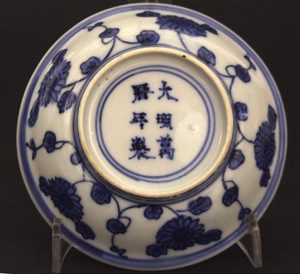
A Pocket-sized Imperial Ming Blueish and White Porcelain Saucer Shape Dish. Six Character Wanli Marker and of the Catamenia. Decorated in a Deep Cobalt Blue With a Constitute With 3 'Ruyi' Shaped Ends and a Border of Fruiting Branches, The Contrary Busy With Flowers.
See our 'Archive' for more information, stock number 17503
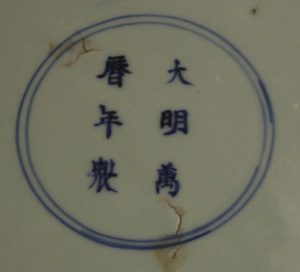
A Saucer Dish, Ming Dynasty. The Base with a Six Graphic symbol Wanli Mark and of the Menstruum (1573-1620). Busy with a Scholar in a Landscape Seated Under a Pine Tree with 2 Attendants, One of whom is Offering a Book. To the Left Can be Seen Tops of Buildings with Clouds Effectually them. The Scholar is Seated Next to a Prunus Tree, with a Minor Amount of Bamboo in the Foreground, While a large Pine Tree Shades Him. These Three Plants, Pine, Bamboo and Prunus, are Referred to as 'The Three Friends of Wintertime'. The Base with a Six Character Wanli Mark and of the Menses (1573-1620) to the Middle, the Rim with Branches of Flowers and Fruit.
See our 'Annal' for more than information, stock number 18909.
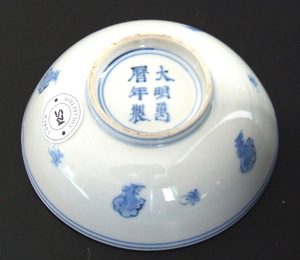
A Pocket-sized Ming Porcelain Bowl. Wanli Six Character Mark and of the Period. Finely Decorated with Buddhist 'Treasures'. Painted in a Silvery Blue (Popular at the End of the 16th century).
For a Wanli Mark and Menstruum Dish of this Blueprint See ; Christie's Hong Kong, The Christina Loke Balsara Drove of Fine Chinese Ceramics, 19th Jan 1988. Lot 258.
Provenance : Robert McPherson Antiques. The John Drew Drove.
Run into our 'Annal' for more information, stock number 18541
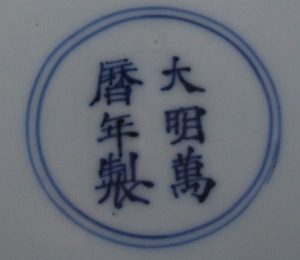
A Fine Ming Blue and White Porcelain Dish. Wanli 6 Character Mark and of the Period. Decorated with Kylin and a Tiger in a Landscape.
For a Wanli Mark and Menses Dish of this Size and Pattern From the Riesco Collection that was Exhibited at the O.C.S. Exhibition of Chinese Bluish and White Porcelain, 14th to 19th Centuries (1953, Catalogue Number 173) Come across : Sotheby'south Fine Chinese Ceramics, Bronzes and Works of Art, London, 11th December 1984. Lot 327.
Provenance : Robert McPherson Antiques. The John Drew Collection.
See our 'Archive' for more than data, stock number 18531
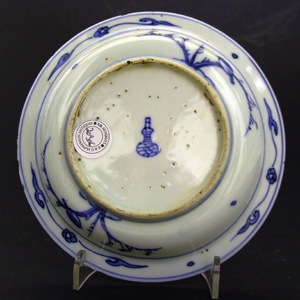
Rare Shaded Double-Gourd Mark, Wanli Period. An Unusual Ming Blue and White Porcelain Dish, Wanli c.1580. Decorated with a Mountainous Landscape to the Center and a Border of Water Birds (Probably Egrets) Among Lotus. The Base with a Rare Shaded Double-Gourd Mark.
See our 'Annal' for more data, stock number 20906
TIANQI 1621 – 1627
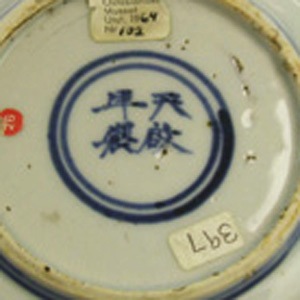
Tianqi Mark and of the Menses (1621-1627) porcelain is unusual. It commonly shows a poorly drawn four character mark which should in near, if non all circumstances, be seen equally none imperial. 6 grapheme marks were also produced, a few could perhaps be imperial but Tianqi's reign is at the very end of the Ming dynasty when regal patronage stopped. The potters of this period found new clients among the scholar classes as well every bit making fine pieces for consign. The pieces illustrated here were fabricated for the Japanese marketplace.
A Tianqi Mark and Period (1621-1627) Ko-Sometsuke Dish Made for the Japanese Market. Painted in Blue and White with a Scholar Sitting Under a Willow Tree.
Provenance :
R & G McPherson Antiques.
The John Drew Drove of Chinese and Japanese ceramics.
Exhibited :
Ostasiatiska Museet. Ulst.1964. Nr 102.
Published :
Ming Blue and White from Swedish Collections past January Wirgin. (Östasiatiska museets utställningskatalog nr 1)
See our 'Archive' or 'Sold' for more information, stock number 20702.
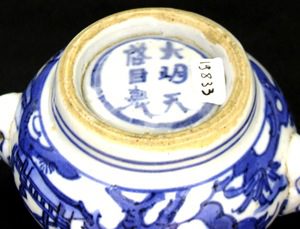
A Rare Tianqi Bluish and White Porcelain Censer, the Base of operations with a Half dozen Character Tianqi (1621-1627) Marking and of the Period. Probably Made for the Tea Anniversary.
This rare belatedly Ming Porcelain incense burner, known as a Koro in Japan, is role of a group of pieces made during the first half of the 17th century for use during the Japanese tea ceremony. It is a rare form and a Tianqi mark is very unusual on shaped vessels. This marking is one of the more unusual Ming Porcelain marks simply when information technology is encountered, it is about always found on minor serving dishes.
See our 'Annal' or 'Sold' for more information, stock number 19833.
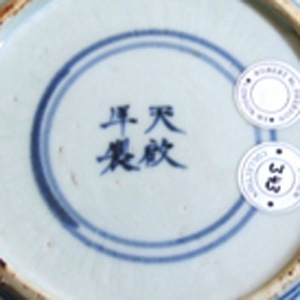
An Unusual Late Ming Wucai Dish. Tianqi Four Graphic symbol Marker and of the Menstruation.
See our 'Annal' or 'Sold' for more information, stock number 18603.
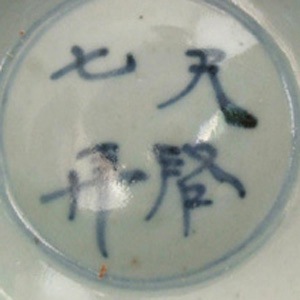
A Rare Dated Ming Porcelain Dish. Sketchily Painted with Four Fundamental Characters Reading 'Tianqi Qinian' ; Tianqi 7th Year (corresponding to 1628). For a Pair of Very Similar Ming Dishes Too Dated 1628 Run across : Christie's London, Fine Chinese Ceramics and Works of Art, December 10th 1990. Lot 161. Provenance : Robert McPherson Antiques. The John Drew Collection.
See our 'Archive' or 'Sold' for more information, stock number 18535.
CHONGZHEN 1628-1644
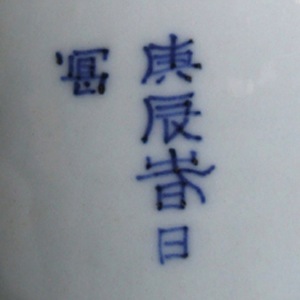
Chongzhen mark and menstruum porcelain is uncommonly rare. Occasionally inscribed pieces like the present case with a date corresponding to 1640 are found, these are never the less very rare too. These pieces are none imperial and were ordinarily dated as function of a dedication to a temple or other building. The inscriptions typically read made during the 12 year of the reign of Chongzhen for example.
A Rare Chongzhen (1628-1644) Porcelain Jar Dated 1640. Decorated with an Open up Mural Scroll, a Vase of Flowers and other Objects. Dated past Inscription to 1640.
Provenance : Christie's London, February. 1979 Lot 52. A Private English language Collection. R & G McPherson Antiques. The John Drew Collection. Illustrated in : The Hatcher Porcelain Cargo'southward (Colin Sheaf and Richard Kilburn, Phaidon 1988).
Meet our 'Archive' or 'Sold' for more information, stock number 18632
MING DYNASTY 1368 – 1644. OTHER MARKS

A Very Rare Inscribed Porcelain Kiln Waster, Probably Ming Dynasty (1368-1644).
Made for testing the quality of the clay this fragment is inscribed 'fifth August Yu Tian Shun Shop 1st Try For Testing the Clay'. This base appears to be inscribed in cobalt, only considering the piece hasn't been glazed it has remained a dark-brown black rather than firing blue. The footrim has non been cut, it has been left every bit a solid. This kiln waster probably comes from Jingdezhen, the Yu Tian Shun workshop would take been 1 of the very many workshops within Jingdezhen.
See our 'Archive' for more data, stock number 18045
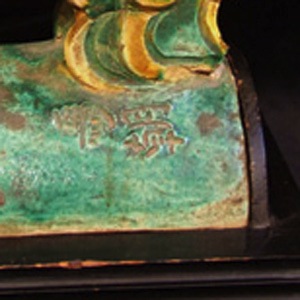
An Unusual Large Ming Dynasty Inscribed Pottery Ridge Tile c.1500-1640. Probably Shanxi Province. The Base of the Mounted Figure of a Warrior is Inscribed Nether the Glaze "Ma Chiu". This is Probably the Name of the Rider, a Historical Chinese Graphic symbol.
Provenance : (According to the former characterization on the base of the fitted stand up) Stuart Earl of Morey Viscount of Findhorn. The Label states that there were ii such figures. We sold the other 1 many years ago.
Meet our 'Archive' or 'Sold' for more data, stock number 19065.
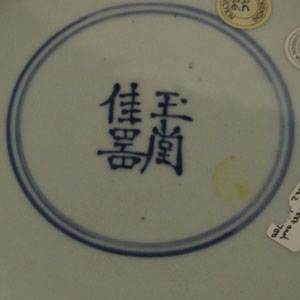
"Fine Vessel for the Jade Hall" :
This 4 character mark establish on some late Ming porcelain was very popular during the Shunzhi Period of 1644 – 1661. Information technology frequently occurs on a group of thickly potted saucer shaped dishes of a blazon that was popular during Shunzhi`s reign. According to Michael Butler (Shunzhi Porcelain, Treasures from an Unknown Reign, Butler, Curtis and little, University of Washington Press,2002) Terese Tse Bartholomew in her book Myths and Rebuses in Chinese Art refers to "Jade Hall" as a wealthy institution, and also an elegant name for the Hanlin Acadamy, an official bureau fabricated upwards of scholars who had attained the highest degrees (politically relevant since the jinshi caste was reinstated past the new regime in 1646.
Source: https://orientalceramics.com/identifying-marks-and-inscriptions/
0 Response to "Chinese Works of Art Hand Painted Box Ming Dynasty"
Post a Comment